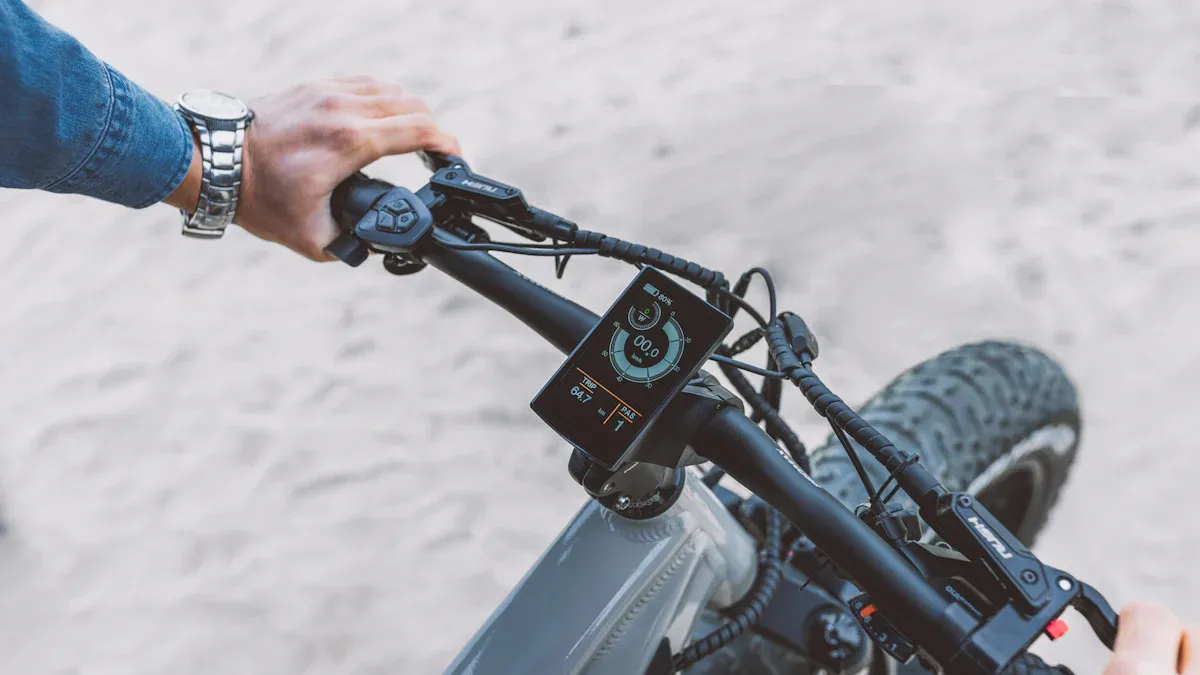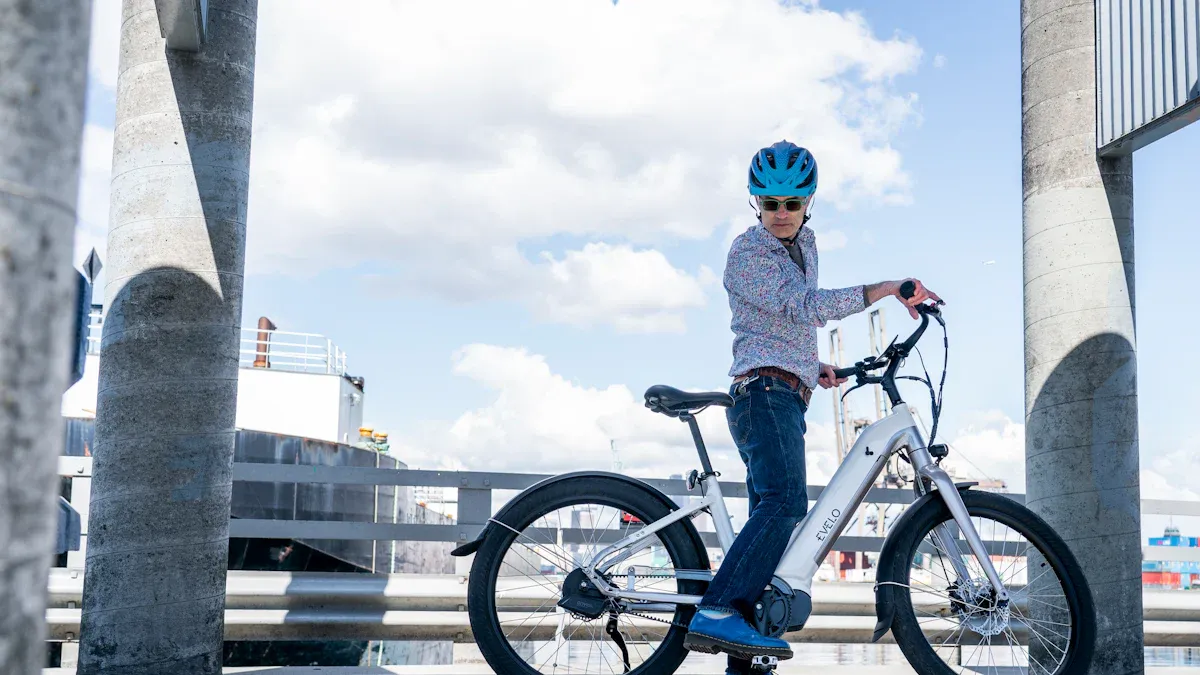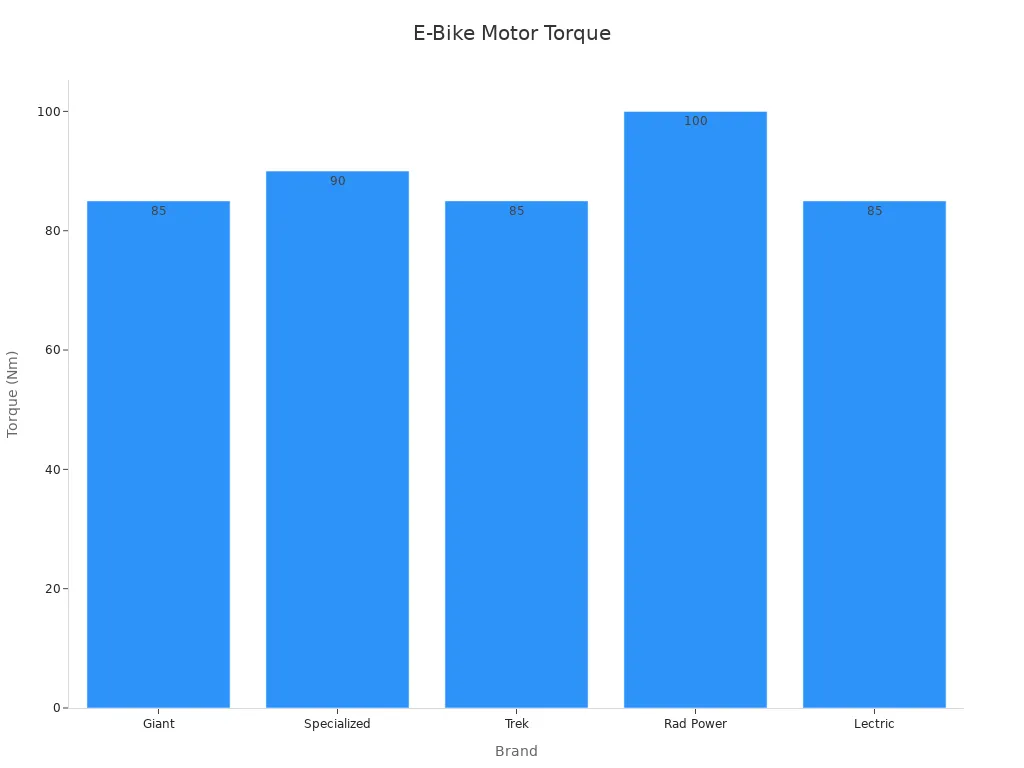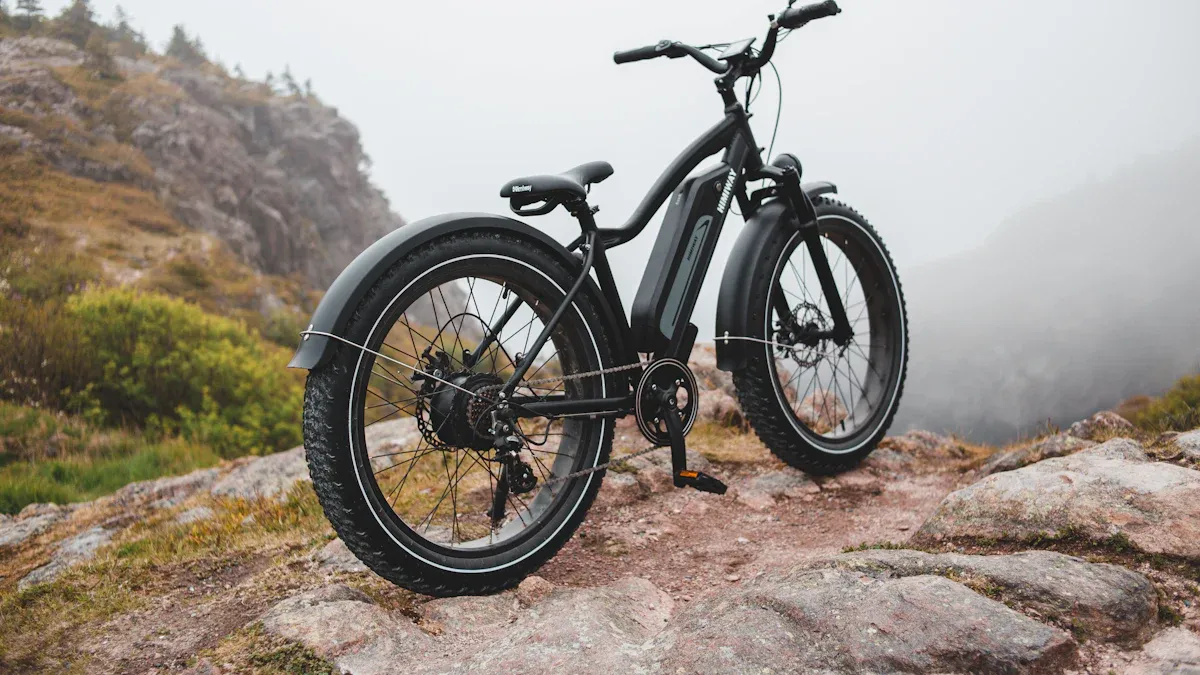
The biggest ebike innovations 2025 focus on making e-bikes smarter, lighter, and greener. Manufacturers are now incorporating artificial intelligence for enhanced safety and real-time route optimization. They are creating lighter frames using advanced materials like carbon fiber and graphene, benefiting both city commuters and off-road riders. Studies reveal that these ebike innovations 2025 improve urban mobility and significantly reduce greenhouse gas emissions. Additionally, e-bike sharing programs and smart battery systems contribute to cleaner cities. The rise of ebike innovations 2025 clearly paves the way for greater sustainability and more convenient daily transportation.
Key Takeaways
E-bikes in 2025 use smart technology like AI and IoT. These help make riding safer and planning routes easier. They also help riders control their bikes better.
Lightweight materials like titanium and carbon fiber are used. This makes e-bikes easier to carry. It also makes them more comfortable to ride.
New solid-state batteries last longer and charge faster. They let riders go farther on one charge.
High torque motors and mid-drive systems give e-bikes strong power. They help riders go up hills and have smooth rides.
Advanced safety features include hydraulic brakes and GPS tracking. Anti-theft systems help protect riders and their bikes.
E-bike sharing programs and public transit work together. This makes city travel greener, easier, and cheaper.
Using recycled materials and green manufacturing helps the environment. It lowers the impact of making e-bikes.
Government policies and lower costs make e-bikes easier to get. This helps more people use them around the world.
Ebike Innovations 2025
Smart Connectivity
IoT Features
Ebike innovations 2025 make e-bikes much smarter. Companies now add Internet of Things (IoT) technology to new e-bikes. These features link bikes to the internet and help riders stay safe. They also make riding easier and more fun. Riders get many benefits, such as:
Real-time traffic management helps riders skip crowded roads.
Air quality monitoring lets people pick cleaner routes.
Emergency response coordination means help comes fast after accidents.
Data sharing with city planners helps improve bike lanes.
Vehicle-to-Everything (V2X) communication lets e-bikes talk to cars and buses.
Blockchain technology keeps data safe and helps stop theft.
Smart infrastructure includes traffic lights that change and weather systems that adjust.
Mobility-as-a-Service (MaaS) frameworks let people pay for different rides in one place.
IoT-enabled docking and charging stations work for many small vehicles.
Digital twin technology uses computer models to help cities plan bike networks.
Data analytics helps cities make safer and greener bike routes.
These top 2025 e-bike features show how IoT changes riding and helps cities get smarter.
App Integration
App integration is a big part of 2025 e-bike features. Riders use apps to check and control their bikes. These apps give:
Remote diagnostics warn users when bikes need fixing.
Personalized ride modes match how each person likes to ride.
Real-time GPS tracking helps with safety and directions.
Apps connect with smart city services like bus times and weather.
With these tools, 2025 e-bike owners have more control and comfort. App systems also let bikes get updates, so they always have the newest features.
AI Integration
Ride Assistance
AI integration is a big step for ebike innovations 2025. Artificial intelligence and machine learning help bikes fit each rider. These systems look at the road, how you ride, and battery life. They change motor help for smoother and better rides. AI can also guess when parts will break and warn riders early. For example, some systems spot brake problems by watching how you speed up and slow down.
VanMoof’s Smart Ride Optimization System, announced in early 2024, uses AI to learn how you ride and what traffic is like. It changes the motor to make rides more comfy and save energy. This smart tech makes every ride feel special.
GPS Tracking
GPS tracking with AI gives new benefits to e-bikes. These systems show where your bike is right now, which helps stop theft and get help fast. AI also finds the best routes by checking traffic and road conditions. Shared e-bike companies use AI to manage their bikes and know when people need them. This helps both riders and city planners.
AI can even turn e-bikes into health tools. The bike checks health numbers and shares them with riders or doctors. The bike or the cloud processes this data, so riders get help and health info.
Tip: Riders can use AI-powered apps for real-time ride tips and health info. This makes every trip safer and more fun.
Ebike innovations 2025 show how AI and IoT work together for smarter, safer rides. These changes help cities become greener and more efficient. Riders also get more control and feel safer.
2025 E-Bike Trends
Lightweight Design
Titanium Frames
Titanium frames are popular in new electric bike trends. Titanium is strong but not heavy. Many brands use titanium to make e-bikes lighter and tougher. Riders feel less shaking because titanium softens road bumps. Brompton uses titanium parts to lower weight but keep bikes strong. Titanium does not rust, so bikes last longer in any weather.
Carbon Fiber
Carbon fiber is a favorite for light e-bike frames. It is strong and weighs very little. Designers use carbon fiber to shape frames for speed and comfort. Many 2025 e-bike trends show carbon fiber for its cool look and easy riding. These bikes are easier to lift and store. Some folding e-bikes weigh about 19 kg with the battery. This is because of carbon fiber and aluminum alloys. Ahooga uses these materials to make bikes that are light and strong.
Note: New e-bikes also use special lithium batteries and small motors to keep weight low.
Aerodynamics
Wind Tunnel Testing
Aerodynamics are important in new e-bike trends. Engineers use wind tunnels to shape frames that move through air better. This helps bikes go faster and saves battery power. Riders notice the change, especially at high speeds or on windy days. Wind tunnel tests help change frame angles and tube shapes for better rides.
Integrated Cabling
Integrated cabling is also big in electric bike trends. Designers hide cables inside the bike frame. This makes bikes look neat and cuts down air drag. Hidden cables keep wires safe from rain and dirt. Riders like the smooth look and better aerodynamics.
Foldable Models
Foldable e-bikes are now very popular in cities. City riders want bikes that fit in small places and work with buses and trains. The folding e-bike market is growing fast because of city life and green travel needs. Many folding e-bikes use light materials and better hinges for quick folding. Riders can take these bikes on trains or put them under desks. Top models have GPS, app checks, and anti-theft systems. Cities like Amsterdam, London, and Seoul support folding e-bikes for daily trips. Millennials and commuters pick these bikes for health and easy use.
Folding e-bikes give:
Easy carrying in busy cities
Simple use with buses and trains
Health perks like less stress
Green ways to travel
Tip: Riders who want easy and green travel should try foldable e-bikes every day.
Batteries

Solid-State
Extended Range
Solid-state batteries are leading the way for 2025 e-bikes. These batteries use solid electrolytes, not liquid ones. This makes them safer and last longer. New research shows these batteries can last three times longer than old ones. SK On and Hanyang University found a way to keep batteries stable for over 300 cycles at room temperature. Riders get longer battery life and do not need to replace batteries as often.
Evidence Aspect | Description |
|---|---|
Extended Cycle Life | Special layers help batteries last much longer than before. |
Electrolyte Manufacturing | Fast photonic sintering makes batteries stronger and last longer. |
Material Innovations | Polymer-oxide and sulfide batteries work better and last longer. |
Relevance to E-bikes | These changes make batteries safer and more reliable for daily rides. |
These new batteries let riders go farther on one charge. Riders also worry less about their battery breaking.
Fast Charging
Fast charging is another big change for batteries. New solid-state batteries can charge faster without getting too hot or losing power. Yonsei University found that letting gel polymer electrolytes cure longer helps batteries last longer, even with fast charging. Riders can now charge their e-bike quickly and get back to riding sooner.
Note: Fast charging helps busy people in cities and makes e-bikes easier to use.
Universal Charging
Standardized Ports
Universal charging is getting more important as more people use e-bikes. But chargers are still different in voltage, amperage, and connector type. Using the right voltage is important to keep batteries safe. Common voltages are 24V, 36V, 48V, and 52V. Amperage changes how fast a battery charges, but too much can make batteries too hot.
Charger connectors include barrel, XLR, and some special types.
Smart chargers turn off by themselves, check temperature, and help keep batteries healthy.
Universal chargers can change voltage and have many adapters, but users must be careful.
Chargers from the bike maker keep batteries safe and keep warranties good.
Good chargers use weatherproof parts and have safety features like overcharge protection.
There are no official rules for universal e-bike chargers yet, but safety checks and good quality help keep charging safe.
Recycling
Eco-Friendly Disposal
Recycling is very important for making e-bikes better for the planet. Making batteries uses lots of energy and materials, so recycling helps the environment. In France, 80% of e-bike batteries get recycled, which is a great effort. Better recycling and stronger batteries should cut emissions by about 35% by 2035.
A 2025 Stanford study says recycling e-bike batteries can lower greenhouse gases by up to 81%, water use by 88%, and energy use by 89% compared to new materials.
The “Hungry for Batteries” program has recycled over 36,000 pounds of e-bike batteries from 52 brands.
Over 12 million e-bikes may be sold in the U.S. from 2020 to 2030, so recycling will matter even more.
Recycling helps the planet by using fewer new materials and making less pollution.
Tip: Riders should always recycle old batteries the right way to help the earth.
Motors
High Torque
Over 85 NM
High torque motors make e-bikes feel much stronger in 2025. These motors help bikes speed up fast and climb steep hills easily. Many new e-bikes have motors with torque over 85 Newton-meters (Nm). This strong torque helps riders start smoothly, even with heavy bags or on bumpy ground.
Hub motors are cheaper and need less fixing, but they use only one gear and are not as strong.
Mid-drive motors are near the pedals and use the bike’s gears. This makes them work better and gives more torque.
Torque sensors check how hard you pedal. They give smooth power, which feels natural to most riders.
Cadence sensors only see if you are pedaling. They give simple help and cost less.
Most e-bike motors are between 250W and 750W. More watts mean more power and speed.
Bigger batteries let you ride farther, but they make the bike heavier.
The table below lists some top e-bike motors for 2025 and what they can do:
Brand | Motor Model | Torque (Nm) | Power (W) | Sensor Type | Additional Notes |
|---|---|---|---|---|---|
Giant | SyncDrive Pro 2 | 85 | N/A | N/A | Works with Yamaha; EnergyPak battery system with 400Wh-800Wh capacity |
Specialized | Turbo Full Power 2.2 | 90 | 565 | Proprietary torque | In-house motor; MasterMind TCU display and Mission Control app for ride customization |
Trek | Bosch Performance CX | 85 | N/A | Torque sensor | Intelligent e-MTB mode; smartphone integration |
Rad Power | Hub motor | 100 | 750 | N/A | Strong hill climbing; 27.5 x 3.0” tires for traction and efficiency |
Lectric | M24 | 85 | 750 | Combined cadence & torque | Custom PWR+ programming for smooth power on hills and heavy loads |

Note: High torque motors make it easy to go up hills and carry heavy things. This is why many people pick powerful e-bikes for work or fun.
Mid-Drive Systems
Mid-drive systems are now the main choice for e-bike motors in 2025, especially in Europe. These motors sit in the middle of the bike, close to the pedals. This spot gives better balance and control. Riders feel steadier, and the bike is easier to handle on any road.
Mid-drive motors use the bike’s gears. This lets the motor use all the gears, so it can give more torque and help on steep hills. Riders do not get as tired, and the ride feels smoother. Delta Electronics made a mid-drive motor in 2024 that weighs just 2.9 kg and gives up to 90 Nm of torque. This motor works well in mountain and cargo bikes, showing how small and strong new motors are.
Mid-drive motors help the battery last longer, so you can ride more miles.
The weight in the center makes the bike easier to steer, even when going fast.
These motors are good for long rides and trips.
Regenerative Braking
Regenerative braking is a new thing in many 2025 e-bike motors. This feature lets the bike save energy when you slow down or go downhill. The motor turns into a generator and sends power back to the battery. Riders can go farther and waste less energy.
Regenerative braking works best in cities where you stop a lot.
It helps the battery last longer and keeps brake pads from wearing out fast.
Riders get smoother stops and use less energy.
Tip: Regenerative braking helps e-bikes use less energy and makes every ride better for the planet.
Safety & Security
Hydraulic Brakes
Hydraulic brakes are now common on e-bikes. These brakes use fluid to move force from the lever to the pads. Riders can stop smoothly and quickly, even in rain or mud. You do not need much hand strength to use them. This helps people of all ages ride safely. Many brands add hydraulic brakes for safety and comfort. Riders can stop faster and control their bikes better on hills. This helps with daily rides and off-road trips. Hydraulic brakes last longer and need less fixing than old types.
Tip: Check your brake fluid and pads often to keep brakes working well.
Rider Monitoring
Rider monitoring has changed how people use e-bikes. These systems track where you are, how fast you go, and your health. GPS tracking gives real-time updates with cell service. Riders get alerts if their bike moves when it should not. Geofencing lets owners set safe areas for their bikes. If the bike leaves, the system sends a warning.
GPS tracking works everywhere and gives fast alerts.
Recovery services get back over 80% of stolen e-bikes with IoT.
Smart locks use fingerprints and alarms, so you do not need keys.
Other features are tamper alerts, ride checks, and emergency help.
AI helps riders use battery power better.
IoT fleet tools help track bikes and fix them before they break.
These tools make riding safer and more comfortable for everyone. They also help cities manage e-bikes and make travel better. Riders feel safer because their bikes have strong protection.
Anti-Theft
E-bike theft is a bigger problem in busy cities now. Makers focus on anti-theft systems for better safety and comfort. Connected e-bikes with IoT can be found over 80% of the time. GPS and alerts help owners and police find stolen bikes fast. For example, a Voltaire e-bike in Paris was found using these tools. Smart locks and alarms have stopped theft, like with a Riese & Müller bike in a basement.
Insurance often needs GPS tracking to cover your bike.
Good trackers can raise recovery from 0% to over 90%.
Over 73% of owners insure their bikes, and IoT bikes get lower rates.
These anti-theft systems help riders worry less. They keep bikes safe and support cleaner, safer travel for all.
Sustainability
Eco Materials
Recycled Aluminum
Many e-bike makers now use recycled aluminum for frames and parts. This keeps bikes strong and light. Using recycled aluminum lowers carbon emissions. It takes less energy than making new metal. Studies show 100% recycled aluminum frames help the environment. Companies use blockchain to check where materials come from. This proves they are sustainable. Europe uses the most recycled materials for e-bikes. Asia-Pacific and North America are starting to use more too. Some brands work together to make new eco-friendly bike materials. These changes help the planet and support green transportation.
Bio-Based Plastics
Bio-based plastics help make e-bikes greener. These plastics come from plants, not oil. Makers use them for seat posts, grips, and battery covers. Some city bikes use bamboo-composite parts too. Bio-based plastics break down faster and use fewer resources. Reports say these materials in e-bikes help reduce waste. They also support a circular economy. Many companies test new bio-resins and recycled plastics. This makes bikes even more eco-friendly.
Note: Picking e-bikes with recycled aluminum and bio-based plastics helps riders support a cleaner environment.
Green Manufacturing
Green manufacturing changes how e-bikes are made. Some factories now use renewable energy. They want to become carbon-neutral. Trek, a top brand, cut emissions per bike by over 50%. The company uses low-carbon aluminum for some models. Trek also extends battery life with smart software. They recycle old batteries to lower emissions more. Refurbishing old bikes saves lots of carbon each year. Factories track waste, recycling, and energy use to see progress. Many now recycle most waste and use less water. These steps make e-bike production cleaner and more efficient.
Key green manufacturing metrics:
Waste kept out of landfills
Recycling rate
Energy from renewable sources
Greenhouse gas emissions
Water use
Battery Recycling
Battery recycling is important for e-bike sustainability. The U.S. may sell over 12 million e-bikes from 2020 to 2030. This means many batteries will need safe disposal. The e-bike industry started the first battery recycling program for transport. The “Hungry for Batteries” project covers over 50 brands. It has recycled more than 36,000 pounds of batteries. A 2025 study found recycling batteries can cut greenhouse gases by up to 81%. It also saves water and energy compared to making new batteries. Companies use new recycling methods to get metals like cobalt and nickel. Some plants use hydrometallurgical processes. These are more efficient and make less waste. Brands like Giant, Trek, and Specialized support these programs. New recycling plants in North America now handle more e-bike batteries each year.
Tip: Riders should always take old batteries to certified recycling centers to help protect the environment.
Urban Mobility

E-Bike Sharing
E-bike sharing is now a big part of city life. These programs let people rent e-bikes for short trips. This makes getting around easy and flexible. Many cities use smart technology to make sharing better. In Nanjing, China, new models helped use 44.6% fewer bikes. The city still met almost every trip request. Montevideo put stations in the best places. This made the system more reliable and connected.
Market reports say e-bike sharing is growing very fast in cities. The market should grow by 11.3% each year from 2025 to 2030. Subscription plans are popular and bring in about 69% of the money. Most systems use docks, so bikes go back to stations. Dockless options are getting more popular because they are easy to use. Asia Pacific leads in e-bike sharing. These programs help cities become greener.
Cities use special tools to check how well sharing works. These tools look at how easy it is to find a bike. They also check if the system connects with buses and trains. Cities like Madrid and Zurich score high. This means they have good coverage and strong links to public transit.
Public Transit Integration
Many cities now link e-bike sharing with public transit. This helps people travel farther and reach more places. Buses and trains do not go everywhere. Studies show using e-bikes with public transit saves money and helps the planet. In Colorado, a test gave e-bikes to workers who needed better ways to get to work. This saved them money on gas and fixing cars. If more people use e-bikes for short trips, cities could save over $400 million in ten years.
Benefit Category | Summary |
|---|---|
Economic Benefits | E-bike use saves money on fuel and maintenance. |
Environmental | Fewer car trips mean less air pollution and lower climate impact. |
Health | Cleaner air and more exercise improve health and reduce missed workdays. |
Social | E-bikes help people in areas with few transit options reach jobs and services. |
Shared e-bikes help people get to buses and trains. Over 90% of shared micromobility riders use public transit. About 81% use e-bikes to reach these services. Many riders do not own cars. Almost half drive less because of e-bikes. Programs that mix e-bikes and public transit make cities fairer. More people can get where they need to go.
Health Benefits
Riding an e-bike is good for your health. People who use e-bikes get more exercise than drivers. Studies show e-bike riders have better heart health and stronger muscles. E-biking is gentle on joints. Even people who do not exercise much can start riding and get fitter.
Riders feel less stress, more happiness, and sleep better.
E-bikes help people with health problems or injuries stay active.
Riding outside lifts mood and helps people make friends.
E-bike commuting means more rides and less sweat, so it is easier for daily trips.
Some of the fastest growing e-bike models focus on comfort and easy use. This makes them a good choice for all ages and abilities. E-bikes help people stay active, enjoy being outside, and feel better in body and mind.
Market Shifts
Competition
The e-bike market is changing fast. More people live in cities now. They also care more about the environment. Many companies want to be the best. Big brands and new startups both compete. They work hard to make better e-bikes. Companies add smart features and strong batteries. Some, like Cannondale, are known for high performance. Cannondale does a lot of research. It has a global network that helps it stay ahead.
Companies want their e-bikes to stand out.
They try new prices and work with partners to sell more.
Brands spend money to make batteries and motors better.
Many now sell e-bikes for cities, mountains, and folding models.
Brands use eco-friendly materials to help the planet.
The electric bike market is growing in many places. Europe is the leader with a value of about $0.941 billion. North America is next, and Asia-Pacific is growing fast. South America and the Middle East are starting to grow too. This is because of new city projects and green ideas.
Affordability
E-bikes cost less than electric cars. More people can buy them now. Charging and fixing an e-bike is cheaper too. This makes e-bikes a smart choice for short trips.
Cost Factor | E-Bike Cost Range | Electric Car Cost Range | Explanation |
|---|---|---|---|
Initial Purchase | $1,000 – $4,000 | $30,000 – $50,000 | E-bikes have a much lower upfront cost. |
Annual Charging | $21 | $500 – $1,200 | Charging an e-bike saves hundreds of dollars each year. |
Maintenance | $100 – $300 | $700 – $1,000 | E-bikes need less maintenance. |
Annual Insurance | ~$50 | $1,000 – $1,500 | E-bikes often do not need insurance or cost much less. |
Cost per Mile | <$0.01 | $0.03 – $0.06 | E-bikes are cheaper for every mile traveled. |
Annual Savings | $4,000 – $6,000 | E-bikes help families save money each year. |
Battery prices are going down. Experts think lithium-ion battery prices will drop by 70% by 2030. This will make e-bikes even cheaper. More people will be able to buy them. Some cities and governments give money back or discounts to help people buy e-bikes.
Tip: Picking an e-bike can save you money on travel, repairs, and health.
Policy Support
Governments help the e-bike market with new rules and programs. These rules make it easier to buy and use e-bikes. In Europe, leaders give money, tax breaks, and build more bike lanes. They want to cut carbon emissions by 2030. This helps the electric bike market grow quickly.
The United States gives grants, tax breaks, and builds more bike paths. Some states add charging stations and make safety rules. These steps help people use e-bikes for work, school, and fun. South Korea and Japan spend money on green travel and better bike lanes. The United Kingdom has “Cycle to Work” and low emission zones in big cities.
Region | Policy Support and Measures | Impact on E-bike Market Growth |
|---|---|---|
Europe | Subsidies, tax breaks, new bike lanes, emission targets | Fast growth, more innovation, higher adoption of cargo and fast e-bikes |
United States | Grants, tax deductions, bike paths, charging stations, safety rules | More people use e-bikes for commuting and recreation |
South Korea | Green mobility programs, new lanes, refund projects | Steady growth, more tech features like GPS and IoT |
United Kingdom | “Cycle to Work,” local grants, low emission zones | Dynamic growth, more investment in infrastructure |
Japan | Carbon reduction policies, support for compact e-bike designs | Stable growth, high use among seniors and city riders |
EU | Subsidies, tax breaks, infrastructure investment, active transport laws | Rapid growth, strong government and private investment |
These rules make it easier for people to pick e-bikes. They help cities get cleaner and safer. As more countries support these ideas, the e-bike market will keep growing.
E-bike changes in 2025 make bikes smarter and lighter for all. Riders get more safety and easier trips in cities. Smart tools like AI help riders during their rides. GPS tracking lets people know where their bikes are. Apps help riders control and check their e-bikes. Cities have cleaner air and less traffic because of e-bikes. The e-bike market is getting bigger as new tech grows. People who watch these trends find better ways to travel. The future will bring even more cool things for e-bike riders.
FAQ
What makes 2025 e-bikes smarter than older models?
E-bikes in 2025 use AI and IoT. These tools help riders in many ways. Riders get route tips while they ride. They can track their health with the bike. The bike checks for problems and tells the rider. Riders use apps to change settings and check their bikes.
How do solid-state batteries improve e-bike performance?
Solid-state batteries last longer than old ones. They charge up faster too. These batteries are safer for riders. You can go farther on one charge. They also weigh less than older batteries.
Are foldable e-bikes strong enough for daily use?
Yes, foldable e-bikes are strong and light. Brands use titanium and carbon fiber to build them. Riders can fold and carry these bikes with ease. They work well on city streets every day.
How do e-bikes help the environment?
E-bikes help lower air pollution in cities. They also help cut down on traffic jams. Many e-bikes use recycled parts and green factories. Battery recycling keeps waste low. Cities get cleaner as more people ride e-bikes.
What safety features do new e-bikes offer?
New e-bikes have hydraulic brakes for quick stops. They use GPS tracking to find lost bikes. Anti-theft alarms help keep bikes safe. Some bikes use AI to spot problems early. Riders get alerts if there is theft or an accident.
Can e-bikes connect with public transit?
Yes, many e-bikes work with city transit apps. Riders can plan trips using bikes and buses or trains. This makes getting around the city easier and quicker.
Are e-bikes affordable for most people?
E-bikes cost much less than electric cars. Battery prices are going down each year. Many cities give rebates or discounts for buying e-bikes. Riders save money on gas and fixing their bikes.
Do e-bikes require special maintenance?
E-bikes need regular checks for brakes, tires, and batteries. Most fixes are easy to do. Many apps remind riders when it is time for service.


